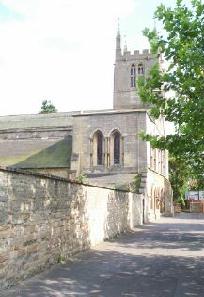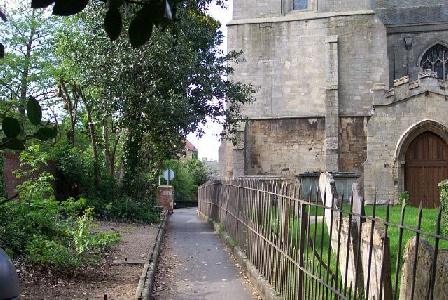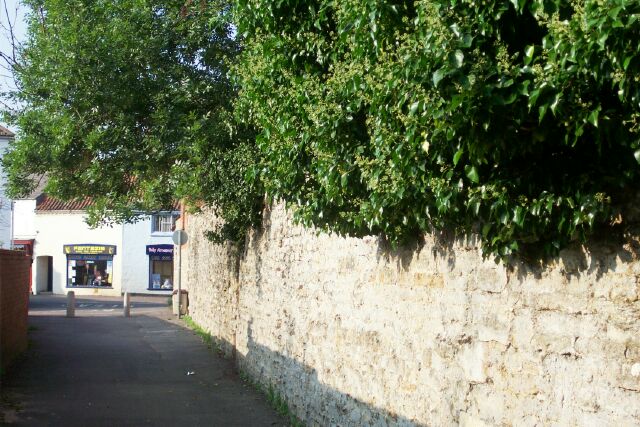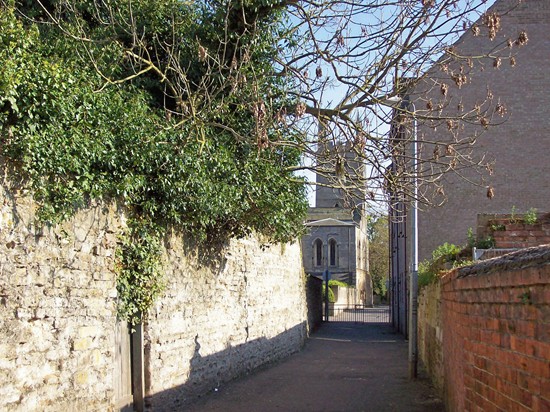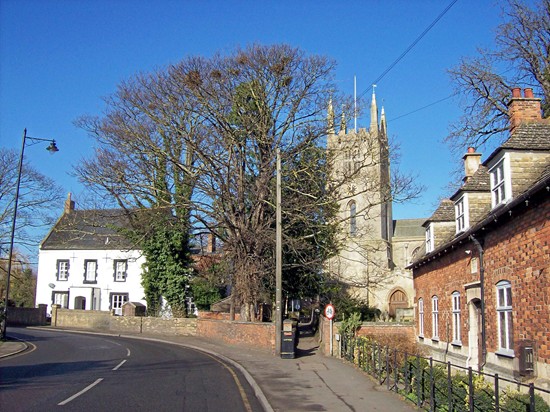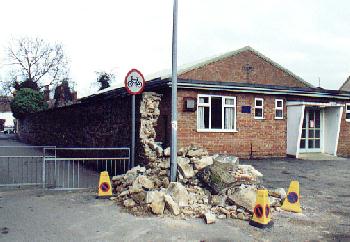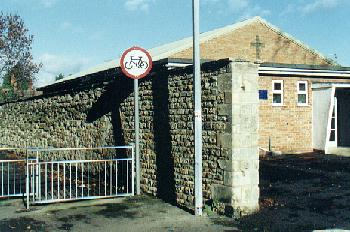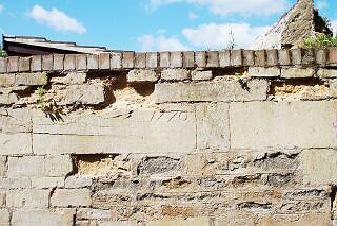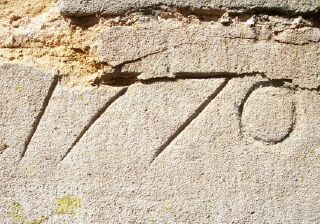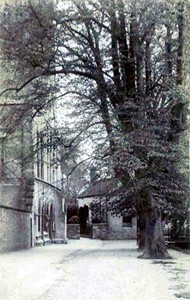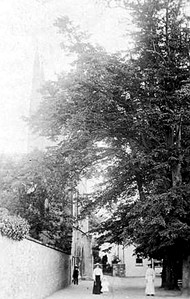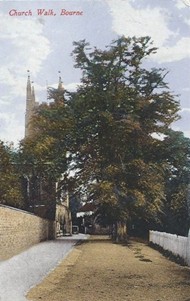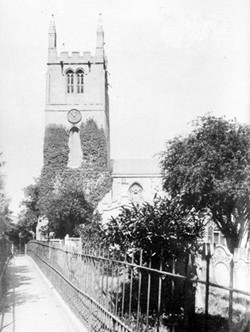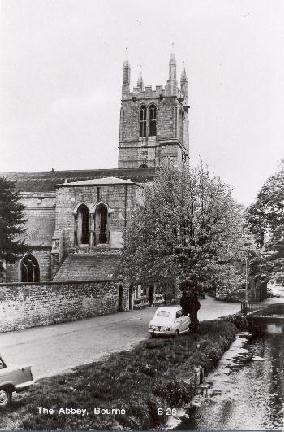|
Church Walk
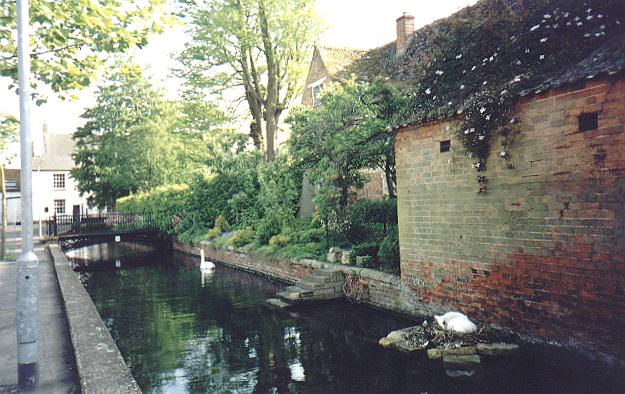
A charming and pleasant
pedestrian way known as Church Walk can be found between Abbey
Road and South Street, running past the Abbey Church and the back
of Bourne
Eau House. This short thoroughfare is full of charming features from
the town's historic past and it is such a secluded place that it
is difficult to imagine that it was once the original Lincoln to
London highway.
The Bourne Eau runs alongside, after
crossing South Street under the road, and this quiet stretch of the
waterway has become home to a pair of swans that regularly raise cygnets
on their nest against the brick wall of an old grain warehouse while
passers-by regularly feed them with bread and other tasty morsels.
There have been many changes here in past years,
notably the disappearance of the commercial buildings, a pea
factory and corn warehouse, but there is still great visual
interest. Along Church Walk you will also find the vicarage, built
in 1986, the church hall dating from the early 1960s and of
course, the Abbey Church dominating the view as it has done for
the past thousand years, a monument to the faith of this town in
grey mellowed stone that looks its best in the late afternoon
sunlight of a hot summer's day.
At
the far end, there is also a path that leads past the churchyard to
South Street itself, once lined with attractive iron railings that were cut
down for the manufacture of munitions during the Second World War of
1939-45 and never replaced.
There
is also an ancient stone wall at the Abbey Road end, built and repaired
over the centuries and therefore containing stones from many periods,
often salvaged from old buildings elsewhere in the town, that can be
distinctly seen by anyone with an eye for the unusual.
An interesting stone wall can be found at the Abbey Road end of Church
Walk which has been here for centuries although the end section was
demolished in 1999 and restored the following year. This wall was
accidentally demolished during the summer of 1999 when it was hit by a
tipper truck working on an extension to the Cedars retirement home nearby.
Contractors accepted responsibility and the wall was rebuilt to its
original condition by the following year.
The
wall on the other side of Church Walk has less character but is equally
interesting, having been maintained and repaired over the years with
materials from many other quarters. One block of well-cut stone is dated
1770 in the distinctive script of the 18th century and most probably came from the old Abbey House
nearby when it was demolished in 1879 to make way for the vicarage, now the Cedars rest and retirement home, and was used to repair the wall.
It is now begun to erode and unless repairs are carried out soon, the
inscription will disappear.
|
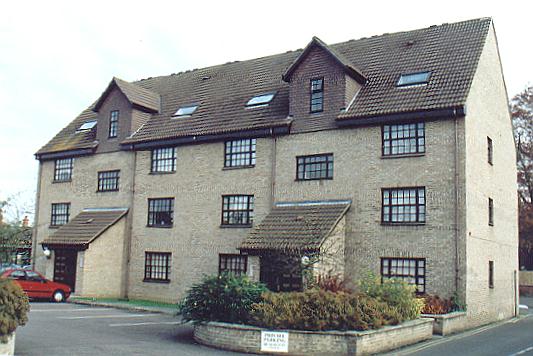 |
The block of flats
in Church Walk stand on the site of a former pea factory, last owned by Wherry & Sons Ltd, an old established Bourne firm that has been
specialising in peas since the 19th century. The factory was built
here in 1902 but closed in 1967 and the building was used for a
time as training workshops for young people but the scheme closed
down and it was eventually demolished to make way for the new flats
in 1990. |
|
OOTPATH CLEAN UP
The footpath
between Church Walk and South Road has been neglected in recent
years but in the summer of 2011, volunteers were recruited by the
church to remove the weeds and accumulated rubbish and give it a
general tidy up in readiness for the judges of the East Midlands in
Bloom competition whose annual visit was imminent. |
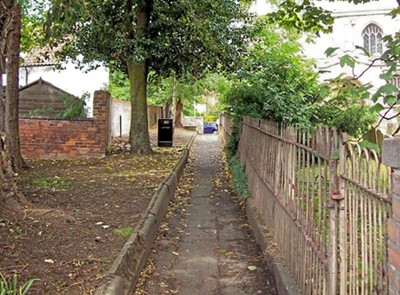 |
|
CHURCH WALK IN PAST TIMES |
|
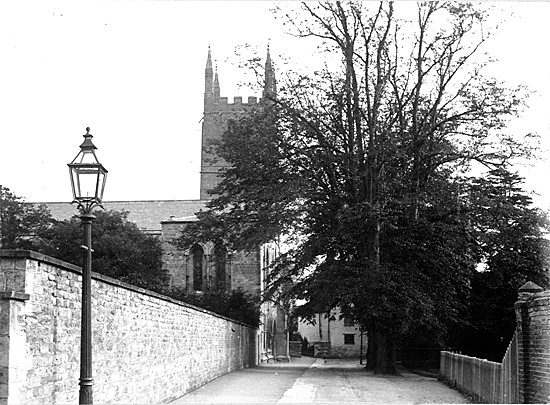 |
|
A view of
Church Walk taken by William Redshaw in 1893. |
|
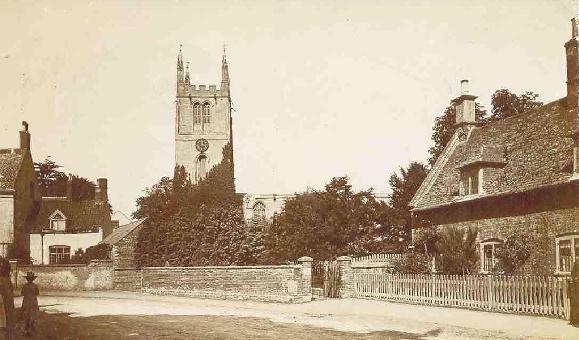 |
|
|
|
These
pictures were taken looking north towards the Abbey
Church circa 1900 and show the neat and tidy state of this
attractive lane in Edwardian times, then as now, a popular
walk for townspeople between the busy shopping centre and
South Street, passing the west front and the churchyard. |
|
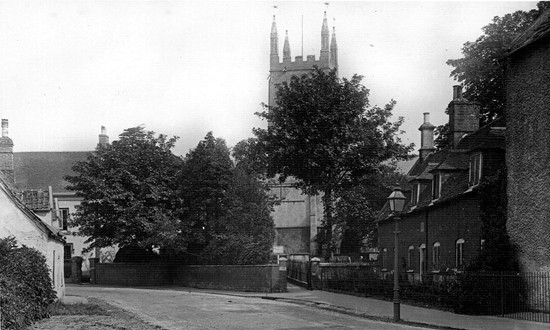 |
|
A picture postcard of Church Walk in 1914. |
|
|
|
The iron railings
on both sides of the lane were then intact but those on the west
side have now disappeared, leaving unsightly metal stumps protruding
from the concrete bases, a reminder that they were cut down and
taken away during the Second World War as scrap metal for recycling
by the munitions industry although
much of that collected was never used and was left to
rust and deteriorate in scrapyards around the country. |
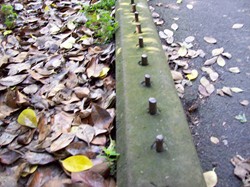 |
|
|
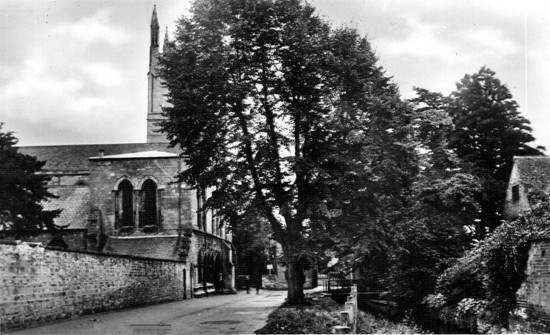 |
|
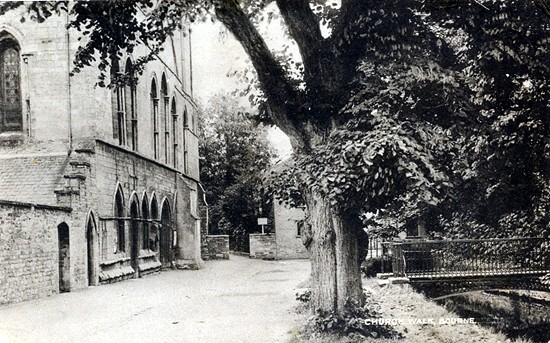 |
|
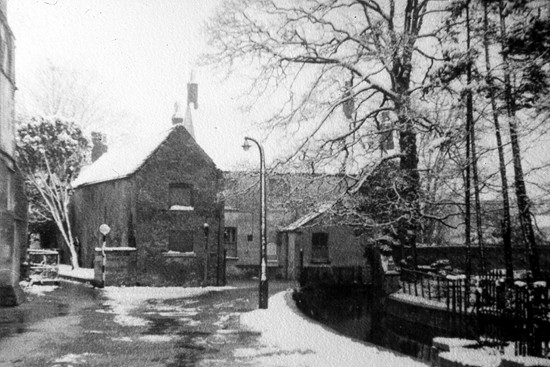 |
|
THE RIVER at this point has always been a hazard for the unwary because there is no protecting
rail and at least one motor car in recent years has nose-dived into the
water while the driver was trying to park although the lady on that
occasion escaped unhurt. In July 1890, the choir of Lincoln Cathedral stopped here for a break while journeying for an engagement at Grimsthorpe Castle and they were accompanied by the cathedral precentor who
was passing on some of his knowledge to the boys about the history of the west front and the tower but his lecture came to an abrupt halt when, overcome by his enthusiasm for the subject, he stepped backwards to secure a better view and fell into the river. Happily the water was shallow and he got out easily but the boys unanimously decided that it was by far the best part of their outing.
The photograph on the left dates from 1920 and that on the right was
taken circa 1950 before the existing reinforcements and low wall
were built as a protection. The picture below was taken on Sunday 2nd September 2007
when parishioners arrived for morning service to find this car in an
alarming predicament. It was owned by a young man living in the
nearby flats who had left it parked overnight but vandals on their way home from the
pub forced the door, released the handbrake and pushed it backwards
towards the river. The police later retrieved the car from this perilous position and
took it away for their experts to examine for finger prints. |
|
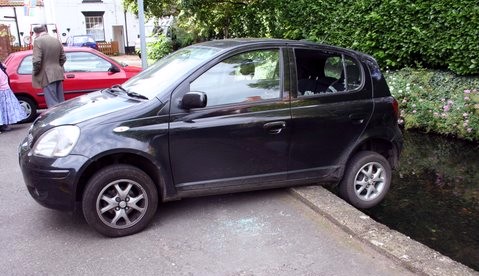 |
|
FENCING OFF THE BOURNE EAU |
|
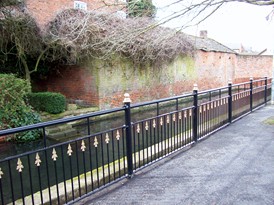 |
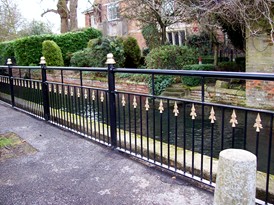 |
|
The problem was finally solved in March 2010
when South Kesteven District Council fenced off the river with iron
railings finished in gold and black trim to match the street
furniture elsewhere around the town and also giving an elegant
appearance to Church Walk. |
|
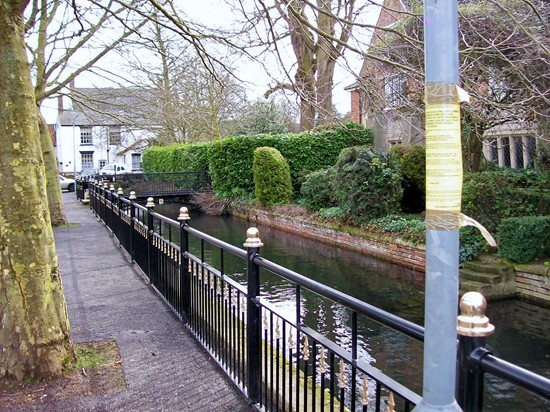 |
|
PHOTO ALBUM |
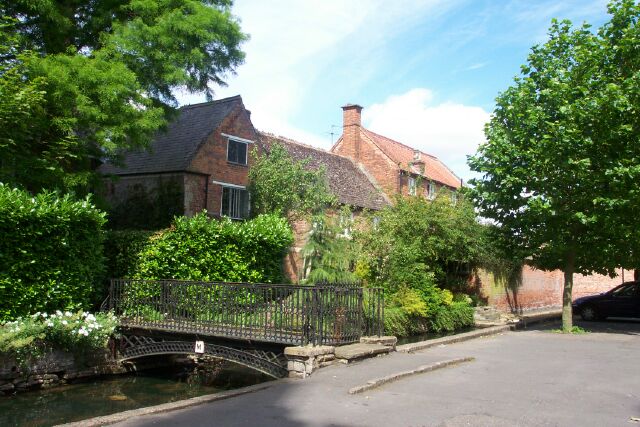 |
|
The imposing property on the west bank of the
Bourne Eau was once
known as The Cedars and now Bourne Eau House. It is probably the
most photographed in the town. The view of the rear from Church
Walk attracts many people with cameras and the cast iron bridge
over the Bourne Eau gives the view added charm. The bridge was built by
the Mawby family when they were in residence in the early 19th century and a small white
plaque contains the initial M and gives the date of construction as
1832. |
|
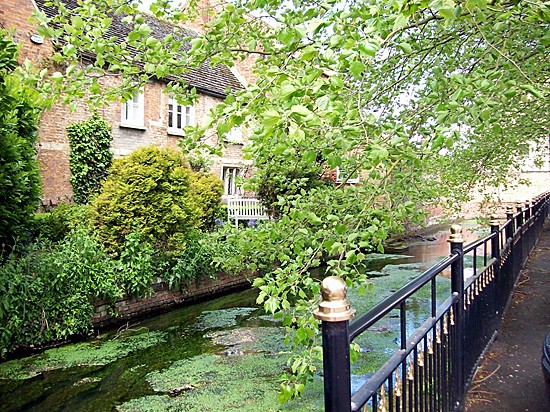 |
REVISED AUGUST 2016
See also
Bourne Eau House
The vicarage
Abbey House

Go to:
Main Index Villages
Index
|

